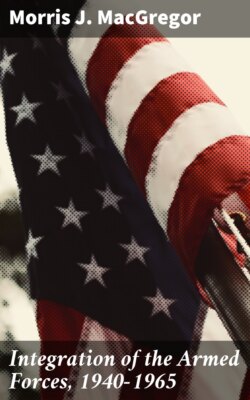Integration of the Armed Forces, 1940-1965

Реклама. ООО «ЛитРес», ИНН: 7719571260.
Оглавление
Morris J. MacGregor. Integration of the Armed Forces, 1940-1965
Integration of the Armed Forces, 1940-1965
Table of Contents
Illustrations
INTEGRATION OF THE ARMED FORCES 1940–1965
CHAPTER 1
Introduction
The Armed Forces Before 1940
Civil Rights and the Law in 1940
To Segregate Is To Discriminate
CHAPTER 2
World War II: The Army
A War Policy: Reaffirming Segregation
Segregation and Efficiency
The Need for Change
Internal Reform: Amending Racial Practices
Two Exceptions
CHAPTER 3
World War II: The Navy
Development of a Wartime Policy
A Segregated Navy
Progressive Experiments
Forrestal Takes the Helm
CHAPTER 4
World War II: The Marine Corps and the Coast Guard
The First Black Marines
New Roles for Black Coast Guardsmen
CHAPTER 5
A Postwar Search
Black Demands
The Army's Grand Review
The Navy's Informal Inspection
CHAPTER 6
New Directions
The Gillem Board Report
Integration of the General Service
The Marine Corps
CHAPTER 7
A Problem of Quotas
The Quota in Practice
Broader Opportunities
Assignments
A New Approach
The Quota System: An Assessment
CHAPTER 8
Segregation's Consequences
Discipline and Morale Among Black Troops
Improving the Status of the Segregated Soldier
Discrimination and the Postwar Army
Segregation in Theory and Practice
Segregation: An Assessment
CHAPTER 9
The Postwar Navy
The Steward's Branch
Black Officers
Public Image and the Problem of Numbers
CHAPTER 10
The Postwar Marine Corps
Racial Quotas and Assignments
Recruitment
Segregation and Efficiency
Toward Integration
CHAPTER 11
The Postwar Air Force
Segregation and Efficiency
Impulse for Change
CHAPTER 12
The President Intervenes
The Truman Administration and Civil Rights
Civil Rights and the Department of Defense
Executive Order 9981
CHAPTER 13
Service Interests Versus Presidential Intent
Public Reaction to Executive Order 9981
The Army: Segregation on the Defensive
A Different Approach
The Navy: Business as Usual
Adjustments in the Marine Corps
The Air Force Plans for Limited Integration
CHAPTER 14
The Fahy Committee Versus the Department of Defense
The Committee's Recommendations
A Summer of Discontent
Assignments
Quotas
An Assessment
CHAPTER 15
The Role of the Secretary of Defense. 1949–1951
Overseas Restrictions
Congressional Concerns
CHAPTER 16
Integration in the Air Force and the Navy
The Air Force, 1949–1951
The Navy and Executive Order 9981
CHAPTER 17
The Army Integrates
Race and Efficiency: 1950
Training
Performance of Segregated Units
Final Arguments
Integration of the Eighth Army
Integration of the European and Continental Commands
CHAPTER 18
Integration of the Marine Corps
Impetus for Change
Assignments
CHAPTER 19
A New Era Begins
The Civil Rights Revolution
Limitations on Executive Order 9981
Integration of Navy Shipyards
Dependent Children and Integrated Schools
CHAPTER 20
Limited Response to Discrimination
The Kennedy Administration and Civil Rights
The Department of Defense, 1961–1963
Discrimination Off the Military Reservation
Reserves and Regulars: A Comparison
CHAPTER 21
Equal Treatment and Opportunity Redefined
The Secretary Makes a Decision
The Gesell Committee
Reaction to a New Commitment
The Gesell Committee: Final Report
CHAPTER 22
Equal Opportunity in the Military Community
Creating a Civil Rights Apparatus
Fighting Discrimination Within the Services
CHAPTER 23
From Voluntary Compliance to Sanctions
Development of Voluntary Action Programs
Civil Rights, 1964–1966
The Civil Rights Act and Voluntary Compliance
The Limits of Voluntary Compliance
CHAPTER 24
Conclusion
Why the Services Integrated
How the Services Integrated, 1946–1954
Equal Treatment and Opportunity
Note on Sources
Official Archival Material
Personal Collections
Interviews
Printed Materials
Index
U.S. GOVERNMENT PRINTING OFFICE: 1981 0–305-168
Отрывок из книги
Morris J. MacGregor
Published by Good Press, 2019
.....
that any person between the ages of eighteen and thirty-five regardless of race or color shall be afforded an opportunity voluntarily to enlist and be inducted into the land and naval forces (including aviation units) of the United States for the training and service prescribed in subsection (b), if he is acceptable to the land or naval forces for such training and service.[1–25]
The Wagner amendment was aimed at volunteers for military service. Congressman Hamilton Fish, also of New York, later introduced a similar measure in the House aimed at draftees. The Fish amendment passed the House by a margin of 121 to 99 and emerged intact from the House-Senate conference. The law finally read that in the selection and training of men and execution of the law "there shall be no discrimination against any person on account of race or color."[1–26]
.....